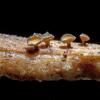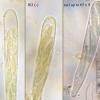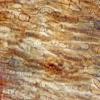
24-12-2025 17:08
Hulda Caroline HolteHello, I have found this propoloid ascomycete on

21-12-2025 09:32
Hello.A tiny ascomycete found embedded in wood in

21-12-2025 21:32
Pol DebaenstHello, Garden, Burgweg 19, Veurne, BelgiumOn 10/1

22-12-2025 23:38
Patrice TANCHAUDBonsoir, récolte sur un mur en pierre, apothéci

22-12-2025 00:47
Patrice TANCHAUDBonsoir, récolte à proximité du milieu dunaire
Crocicreas (Cyathicula) on subalpine environment
Enrique Rubio,
26-06-2012 13:48
Have you some idea for our collection of this Crocicreas species growing on Veratrum album old stems at 1800 m of altitude?
The hymenium is yellowish and the excipulum brownish or blackish. The asci are 8-spored, IKI negative, up to 65 x 9, and they have croziers.
Spores hyaline, fusoid, eguttulate, straight to curved or sigmoid.
I have seen any species (Zotto's CD, Carpenter's paper...) with these data.
Thank you for your help
Enrique
Hans-Otto Baral,
26-06-2012 17:50

Re : Crocicreas (Cyathicula) on subalpine environment
Hi Enrique
I have only Heterosphaeria veratri in my database with such spores.
No idea! C. megalospora has larger spores with oil and grows on monocots.
Zotto
I have only Heterosphaeria veratri in my database with such spores.
No idea! C. megalospora has larger spores with oil and grows on monocots.
Zotto
Enrique Rubio,
26-06-2012 18:16
Re : Crocicreas (Cyathicula) on subalpine environment
Thank you, Zotto. Really Heterosphaeria veratri is a common species at this place, but I think it's a very different fungus.
Enrique
Enrique




